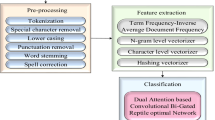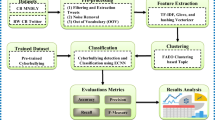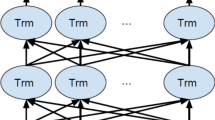Abstract
Recently, the crime rates in social media are rising rapidly and it produces serious problems to the users. From the past few years, twitter platform has been gaining higher attention due to its effective services. But, the growth of crimes in twitter generates several issues and it redirect users to malicious or phishing websites. Thus, in order to identify various illegal activities on twitter, the proposed study introduces a robust Deep Attention Convolutional Bi-directional Aquila Optimal Network (DAC-BiNet) model. For effectively processing the proposed network, the raw inputs are pre-processed initially to reduce the noises through diverse steps like segmentation of sentences, punctuation removal, tokenization, removal of stop words, acronym and slang correction, lemmatization, lower casing, stemming, removal of hashtag and URLs. From the pre-processed data, the significant features are extracted using ITF-IDF (Improved Term Frequency-Improved Document Frequency), Feature hashing and Glove Modelling methods. Then, the feature dimensionality issue is solved by grouping the features into clusters by Possibilistic Fuzzy LDA (Latent Dirichlet Allocation) based clustering method. Finally, classification stage is initiated to identify the crime tweets in the given inputs through proposed DAC-BiNet model. The proposed study used python platform for simulation and the efficiency of proposed model is measured by evaluating various performance matrices and comparing with other existing techniques. The obtained simulation results proves that proposed model gains enhanced accuracy of 98.23%, precision of 83.86%, recall of 90.05%, specificity of 98.86%, and F1 score of 86.84%.










Similar content being viewed by others
Data availability
The manuscript does not have any associated data which was generated.
References
McMullan JL, Rege A (2010) Online crime and internet gambling. J Gambl Issues 24:54–85
Drew JM, Moir E, Newman M (2021) Financial crime investigation: an evaluation of an online training program for police. Polic Int J 44(3):525–539
Almadhoor L (2021) Social media and cybercrimes. Turk J Comput Math Educ (TURCOMAT) 12(10):2972–2981
Razak NA, Abdul Malik HK, Rentah F, Mazlan MNH (2021) A Comprehensive Study of Privacy and Security Risk Awareness Among Mobile Internet Users for Social Networks Sites in Malaysia. Int J Bus Technol Manag 3(1):1–20
Sandagiri C, Kumara BTGS, Kuhaneswaran B (2021) Deep Neural Network-Based Crime Prediction Using Twitter Data. Int J Syst Service-Oriented Eng (IJSSOE) 11(1):15–30
Metzger MJ, Flanagin AJ, Mena P, Jiang S, Wilson C (2021) From dark to light: The many shades of sharing misinformation online. Media Commun 9(1):134–143
Thurtell SC (2021) When Shopping Turns Scary: Twitter Conversations about Violent Crime in Johannesburg Malls. Critical Arts 35(1):85–96
Mahor V, Rawat R, Telang S, Garg B, Mukhopadhyay D, Palimkar P (2021) Machine Learning based Detection of Cyber Crime Hub Analysis using Twitter Data. In 2021 IEEE 4th International Conference on Computing, Power and Communication Technologies (GUCON), pp 1–5. IEEE
Dutta HS, Aggarwal K, Chakraborty T (2021) DECIFE: Detecting collusive users involved in blackmarket following services on Twitter. In Proceedings of the 32nd ACM Conference on Hypertext and Social Media, pp 91–100
Asaad RR, Abdulhakim RM (2021) The Concept of Data Mining and Knowledge Extraction Techniques. Qubahan Acad J 1(2):17–20
Saura JR, Palacios-Marqués D, Ribeiro-Soriano D (2021) Using data mining techniques to explore security issues in smart living environments in Twitter. Comput Commun 179:285–295
Ojha D, Singh RP, Jadon KS (2021) An Analysis on Data Mining for Sentiment Analysis Using Different Classification Algorithms. In 2021 10th IEEE International Conference on Communication Systems and Network Technologies (CSNT), pp 533–538. IEEE
Ahadi A, Singh A, Bower M, Garrett M (2022) Text Mining in Education—A Bibliometrics-Based Systematic Review. Educ Sci 12(3):210
He J, Nguyen DQ, Akhondi SA, Druckenbrodt C, Thorne C, Hoessel R, Afzal Z et al (2021) Chemu 2020: Natural language processing methods are effective for information extraction from chemical patents. Front Res Metrics Anal 6:12
Benicio DHP, Xavier-Júnior JC, de Paiva KRS, De Araújo Sant Camargo JD (n.d.) Applying Text Mining and Natural Language Processing to Electronic Medical Records for Extracting and Transforming Texts into Structured Data
Raja RA, Yuvaraj N, Kousik NV (2021) Analyses on Artificial Intelligence Framework to Detect Crime Pattern. Intelligent Data Analytics for Terror Threat Prediction: Architectures, Methodologies, Techniques and Applications, pp 119–132
Rouhollahi Z (2021) Towards Artificial Intelligence Enabled Financial Crime Detection. arXiv preprint arXiv:2105.10866
Rigano C (2019) Using artificial intelligence to address criminal justice needs. Natl Inst Justice J 280:1–10
Chackravarthy S, Schmitt S, Yang L (2018) Intelligent crime anomaly detection in smart cities using deep learning. In 2018 IEEE 4th International Conference on Collaboration and Internet Computing (CIC), pp 399–404. IEEE
Lal S, Tiwari L, Ranjan R, Verma A, Sardana N, Mourya R (2020) Analysis and classification of crime tweets. Procedia Comput Sci 167:1911–1919
AlGhamdi MA, Khan MA (2020) Intelligent analysis of Arabic tweets for detection of suspicious messages. Arab J Sci Eng 45(8):6021–6032
Santhiya K, Bhuvaneswari V, Murugesh V (2021) Automated Crime Tweets Classification and Geo-location Prediction using Big Data Framework. Turk J Comput Math Educ (TURCOMAT) 12(14):2133–2152
Boukabous M, Azizi M (2022) Crime prediction using a hybrid sentiment analysis approach based on the bidirectional encoder representations from transformers. Indones J Electr Eng Comput Sci 25(2):1131–1139
Hissah AS, Al-Dossari H (2018) Detecting and Classifying Crimes from Arabic Twitter Posts using Text Mining Techniques. Int J Adv Comput Sci Appl (IJACSA) 9(10)
Abualigah L, Yousri D, AbdElaziz M, Ewees AA, Al-Qaness MAA, Gandomi AH (2021) Aquila optimizer: a novel meta-heuristic optimization algorithm. Comput Ind Eng 157(3):107250
Funding
No funding was received for conducting this study.
Author information
Authors and Affiliations
Corresponding author
Ethics declarations
Ethical approval
This article does not contain any studies with human participants or animals performed by any of the authors.
Conflicts of interests
The authors declare that they have no conflict of interest and have no competing interests to declare that are relevant to the content of this article.
Additional information
Publisher's note
Springer Nature remains neutral with regard to jurisdictional claims in published maps and institutional affiliations.
Rights and permissions
Springer Nature or its licensor (e.g. a society or other partner) holds exclusive rights to this article under a publishing agreement with the author(s) or other rightsholder(s); author self-archiving of the accepted manuscript version of this article is solely governed by the terms of such publishing agreement and applicable law.
About this article
Cite this article
Monika, Bhat, A. DAC-BiNet: Twitter crime detection using deep attention convolutional bi-directional aquila optimal network. Multimed Tools Appl 83, 44121–44145 (2024). https://doi.org/10.1007/s11042-023-17250-4
Received:
Revised:
Accepted:
Published:
Issue Date:
DOI: https://doi.org/10.1007/s11042-023-17250-4




